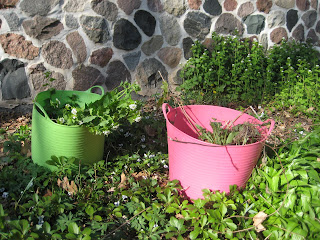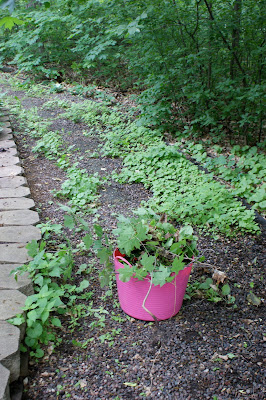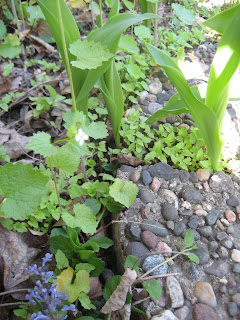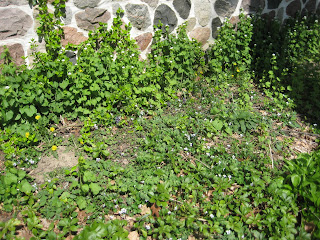Tag: garlic mustard
Garden Bloggers Bloom Day – May
May 17, 2011
Garden Bloggers Bloom Day is the 15th of each month. The idea is to chronicle the progression of our garden’s through the seasons by taking pictures and creating a blog post on the 15th. This month I was halfway there. I got the pictures taken…but getting this post up, well, better late than never, right???
This long, cool, seemingly never ending spring (late winter???) has highlighted how badly my garden needs spring flowering bulbs. That will be an initiative of mine this fall. In the actual cultivated parts of the garden, there’s little in bloom. The garden is just waking up, beginning to kick into gear. The spring renewal of the garden provides a little treasure hunt for me as I wander. Reminding me of the plants I’ve added, remembering their origins.
The Amelanchier ‘Princess Diana’ purchased 4 years ago from the Missouri Botainc Garden plant sale as a tiny rooted cutting. Grown for 3 years in a pot, moved from house to house, and now in ground, taking shape as a small tree in this garden.
Thankfully, Mother Nature has my back, and is providing some glorious woodland natives. Throughout my woods, clusters of Arisaema triphyllum(Jack-in-the-Pulpit) pictured at the top of this post. Masses of trillium.
However, within this all lurks a bit of evil. Masses and masses of Garlic Mustard (Alliaria petiolata), a noxious weed, introduced from Europe and threatening native plants throughout the Midwest. And I do mean masses. In clusters together, between the other plants, Best controlled by pulling, which when at flowering height is easy. However, lurking below millions and millions of tiny seedlings. I’ve read a single plant can produce 50,000 seeds, seeds that remain viable in the soil for 6 years. Garlic Mustard plants are alleopathic producing chemicals in the soil that inhibit the growth of other plants.
Wordless Wednesday: Making Progress or Futile Effort
June 9, 2010
Be afraid, be very afraid……
April 18, 2010
At first glance, a charming scene. Some sort of groundcover weaving its way between the Lily of the Valley. But step back a bit, look at the whole scene, and you quickly realize that is not the case.
This is our third spring since we relocated to Wisconsin, the second in this house. The first spring was spent in “corporate housing” while we searched for a house. That apartment backed up to the fox river plain. During that spring I marveled at the wild turkey that wandered onto our patio, the occasional sighting of a fox, and wondered about the plant with white flowers that seemed to be taking over the landscape.
Garlic Mustard (Alliaria petiolata), at first glance such an innocent looking plant. Presumably introduced from Europe for culinary or medicinal properties, but one of those plants that outside of its native habitat has proven invasive, crowding out other plants. Endangering the natural habitat.
And it’s no wonder. These lines from the King County, WA noxious weeds website pretty much sum it up:
“The fact that it is self fertile means that one plant can occupy a site and produce a seed bank. Plant stands can produce more than 62,000 seeds per square meter to quickly out compete local flora, changing the structure of plant communities on the forest floor. Garlic mustard is also allelopathic, producing chemicals that inhibit the growth of other plants and mychorrizal fungi needed for healthy tree growth and tree seedling survival.”
Last year, I did my best to pull up or cut off flowers of the plants I saw around the yard, but hadn’t noticed the small seedlings. In fact, I hadn’t really studied up on the plant and assumed this was an annual. I wasn’t looking for the first year seedlings. Yesterday, as I attacked the current season crop, the long tap roots of the plant made me realize, this was no annual. This is a biennial. Meaning it grows two season – seeds sprout in the first spring, flowers in the second spring, sets seeds and dies. And this plant does all that with remarkable vigor. This robust root structure is not the result of a single spring’s growth, and explains why the WI DNR site says not to just cut off the tops in the spring. This is a plant built to survive, it can re-sprout, is built to do so.
And that’s when I noticed the seedlings. Thousands and thousands of them. Between rocks, under plants, in the walkways. EVERYWHERE.
This spring’s seedlings in the the cracks of the retaining wall will become next spring’s plants.

The local recycling center will not accept garlic mustard, which tells me not to compost it. This means my weeding has now become a two trug job, one for the “normal” weeds, and one for the garlic mustard. In my old Kentucky and southern Illinois gardens, I fought henbit and chickweed each spring. Thought those were the worst things to battle. Know I have a much more formidable opponent in this plant. Will have to be much more vigilant, but is it me or the garlic mustard who needs to be afraid…at least in this little patch of ground.









